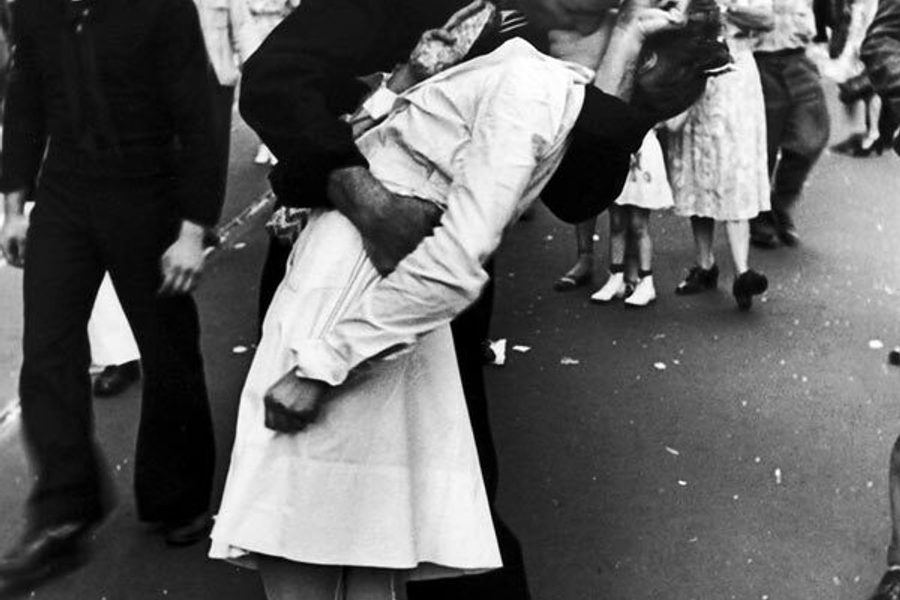
You know “The Kiss,” Eisenstaedt’s famous photograph of a sailor kissing a nurse, in Times Square on V-J Day. It’s an iconic image. It’s love, it’s romance, it’s victory, it’s elation. It’s the last G-rated shot before the Greatest Generation went home to start the Baby Boom.
Except it isn’t.
Until recently, the identities of the sailor and the nurse remained a mystery. This left us free to write our own backstories. Being a hopeless romantic, I assumed that two were a couple reuniting at last. Others thought they were strangers exhilarated by the end of World War Two. Whatever it was, it looked like it was mutual.
Over the years, various people have claimed to be the subjects of “The Kiss,” but historians now believe that the nurse is one Greta Zimmer Friedman and the sailor one George Mendonsa.
When asked about the famous embrace, Friedman told reporters that Mendonsa grabbed her and kissed her against her will. A blogger known as The Leopard wrote an essay about the media coverage entitled, The Kissing Sailor, Or The Selective Blindness of Rape Culture:
It seems pretty clear, then, that what George had committed was sexual assault. Yet, in an amazing feat of willful blindness, none of the articles comment on this, even as they reproduce Greta’s words for us. Without a single acknowledgement of the problematic nature of the photo that her comments reveal, they continue to talk about the picture in a whimsical, reverent manner, “still mesmerized by his timeless kiss.” George’s actions are romanticized and glorified; it is almost as if Greta had never spoken.
Leopard’s post went viral and sparked heated debate. Critics howled that a forced kiss isn’t really a sexual assault, and besides, it’s not fair to judge George by contemporary sexual mores. These critiques completely miss the point. Leopard isn’t trying to litigate the act depicted in the photo, she’s asking why reporters are still celebrating “The Kiss” as a romantic image when they know the decidedly unromantic truth.
We now know that George had been running around drunkenly grabbing various women and mugging for the camera. It wasn’t even a spontaneous display of passion on his part. It was a drunk guy grabbing women like so many mannequins. They were his V-J Day trophies.
The point isn’t whether Greta was traumatized, or whether George broke New York State law as written in 1945, or whether the local authorities handled the incident properly amid the hubbub of V-J Day. We needn’t hold a grudge against George. Sixty-seven years is time enough to live down this relatively minor bit of dickishness.
The point is that “The Kiss” isn’t the mutually joyous embrace we thought it was. We thought it was a picture of something heartwarming by 2012 standards, but it turned out to be something icky and wrong by 2012 standards. The standards of 1945 don’t enter into it. We cherish the photo because of how it makes us feel today.
Instead of just accepting that we were mistaken, the goalposts are being shifted to: Well, it wasn’t an assault in 1945. It might as well have been consensual because men could grab women at will in those days.
We all thought the photo was one thing, and it turned out to be something completely different. And then, when the woman explained what really happened, everyone ignored her and went right back to celebrating their original idea of the photo. It was as if she’d never spoken.

I hope you found this article important. Before you leave, I want to ask you to consider supporting our work with a donation. In These Times needs readers like you to help sustain our mission. We don’t depend on—or want—corporate advertising or deep-pocketed billionaires to fund our journalism. We’re supported by you, the reader, so we can focus on covering the issues that matter most to the progressive movement without fear or compromise.
Our work isn’t hidden behind a paywall because of people like you who support our journalism. We want to keep it that way. If you value the work we do and the movements we cover, please consider donating to In These Times.



